
| home | catalogue | history | references | appendix |
 |
surfresearch.com.au
surfriding in west africa
|
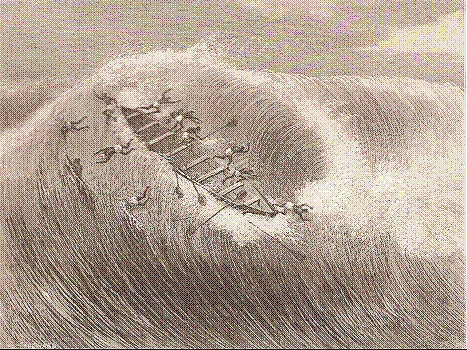
Unaccredited: Surf-boat
wipe-out on a large curling right-hander,
Senegal - Nigeria, circa
1850.
Image contributed by Herve
Manificat, July 2013, publishing details to be confirmed.
In the most
detailed account of African surfriding, John Adams (1823)
writes of Fantee children amusing themselves in the
ocean using terminology reminiscent of many reports from
Polynesia.
On "pieces of
broken canoes, which they launch, and paddle outside of the
surf, when, watching a proper opportunity, they place their
frail barks (boards) on the tops of high waves, which, in
their progress to the shore, carry them along with great
velocity."
That the
surfboards are described as "pieces of broken canoes,"
is significant.
In his seminal
account of surfriding in Tahiti, Joseph Banks (1769)
describes the craft, perhaps a little inaccurately, as "the
stern of an old canoe."
Broken canoes,
most likely splitting longitudinally with the grain and with
the timber already finished, would have been readily recycled,
and one possible option was as a surfboard.
In the Ellice
Islands, Kennedy (1930)
notes that the puke (the shaped bow covering of the
canoe) is often used as a surfboard, and Bligh (1788) reported the
Tahitians, on one occasion, were surfriding on the blades of
their canoe paddles.
(This last case
was probably an aberration given the extreme surf conditions
at the time- during this week every surfboard in Matavai Bay
would have been in high demand).
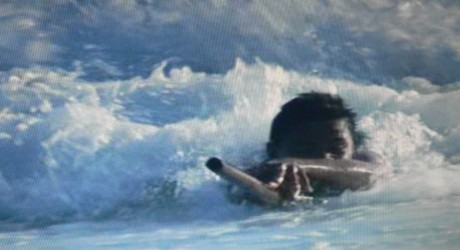 Anuta 1. |
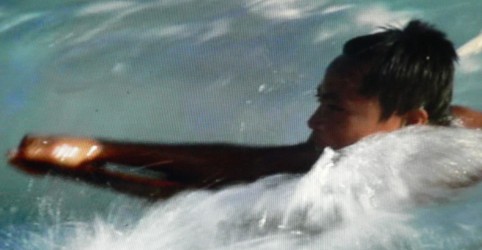 Anuta 2. Plate2. Ashley Raakie,
Honiara, Solomon Islands, August 1988. |
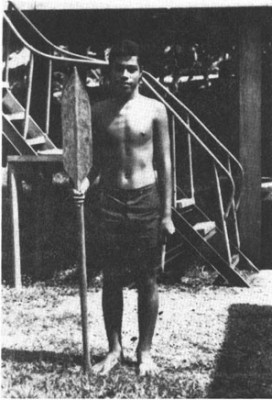 |
Adams
identifies the essential skill in a successful ride following
the take-off; that is, maintaining the board's position in
curl of the wave.
In his own
words, "the principal art of these young canoe men consists in
preserving their seats while thus hurried along, and which
they can only do by steering the planks with such precision,
as to prevent them broaching to ; for when that occurs, they
are washed off, and have to swim to regain them."
Again, similar
to Polynesian accounts, the children, "not more than six or
seven years of age," swim expertly, and surfriding is
community event, the best rides receiving " the plaudits of
the spectators, who are assembled on the beach to witness
their dexterity."
After arriving
by native canoe through "two or three lines of heavy rollers"
at Accra in modern day Ghana, James Alexander (1835),
like Adams, also observed juvenile surfboard riding.
In a brief
account he wrote of "boys swimming into the sea, with light
boards under their stomachs.
They waited for
a surf (wave); and then came rolling in like a cloud on the
top of it."
In a
later conversation, he was told that the local
surfriders were occasionally threatened by sharks.
At Batanga
(Cameroon), Thomas J. Hutchinson
(1861) observed the local fisherman surfriding in their canoes
where the waves broke on an extensive reef.
Apparently, the
conditions on this day were unfavourable for serious fishing,
or particularly suited to canoe surfriding, or a combination
of both.
He writes of a
group of the four or six riders in small light-weight one-man
canoes.
Hutchinson
describes the paddle-out, take-off, steering with a trailing
paddle at speed, and the inconvenience of the wipe-out,
somewhat mitigated by their being "capital swimmers – indeed,
like the majority of the coastal negroes, they may be reckoned
amphibious.".
Sharks are an
occasional hazard; Hutchinson was told that, shortly before he
arrived, a fisherman died after losing a leg to "a prowling
shark.""
While there
are numerous accounts of (adult) West Africans riding waves in
canoes, in those instances they are invariably in pursuit of
their livelihood, either in transporting freight or
passengers, or in returning from fishing.
In this case,
the Batanga canoe riders are clearly riding the waves for
simple pleasure, and in this sense, as noted by Kevin Dawson(2009),
it
is "the only (account from West Africa) that describes adults
surfing (recreationally)."
In the second of two books of her
travels to West Africa, a photograph by Mary H. Kingsley (1899)
shows six Batanga men and their canoes, possibly identical to
those observed surfriding by Hutchinson forty years earlier..
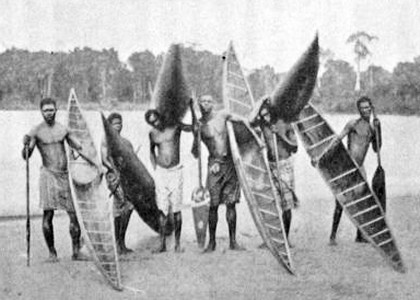
Mary H. Kingsley: Batanga
Canoes, West Africa, c1899.
When visiting the coast of the
Batanga people, C. S. Smith
(1895) observed and detailed their very light cork wood single
canoes; going so far as to weigh one, at an impressive
twenty-seven pounds.
Too narrow to seat an ordinarily
sized person, a narrow "saddle" laid across the gunwales was
used as a seat, and with very light paddles, they "scud over the
roughest sea without danger and with almost incredible
velocity."
Paddling predominantly with left
hand, the right is occasionally used to bail, and one foot is
trailed as balance, and presumably to assist in manoeuvring
Thus, "when they would rest their
arms, one leg is thrown out on either side of the canoe, and it
is propelled almost as fast with their feet as with the
paddle.".
While employed to lay undersea
cables On a Surf-bound Coast (the title of his book),
Archer P. Crouch
(1887) had many experiences in landing and launching in
surf-boats and canoes.
However it is his rare account of
swimming in considerable sized surf and taking instruction in
the art of body surfing from his African assistant, Su, that is
remarkable
In his ethnographic study of the
Tshi-speaking peoples of the Gold Coast, Alfred Burdon Ellis (1887) wrote
that "every portion of the shore where the surf breaks unusually
heavily, or rocks cause the water to become broken, and ...
dangerous for canoes, has its local spirit."
Capt. T. C. Hincks: Surf-Boats comming of from Cape Coast Castle, (Gold Coast), 1910. Printed in Johnston, Harry Hamilton, Sir : Britain across the Seas: Africa ... the British Empire in Africa, 1910, page 288. Internet Archive https://archive.org/details/britainacrosssea00johnuoft |
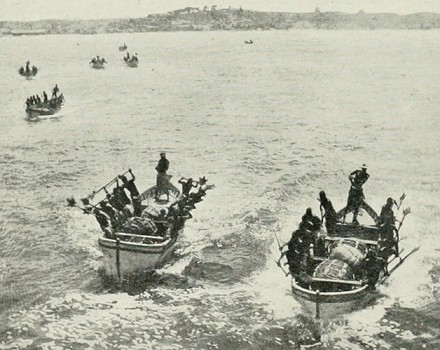 |

| home | catalogue | history | references | appendix |